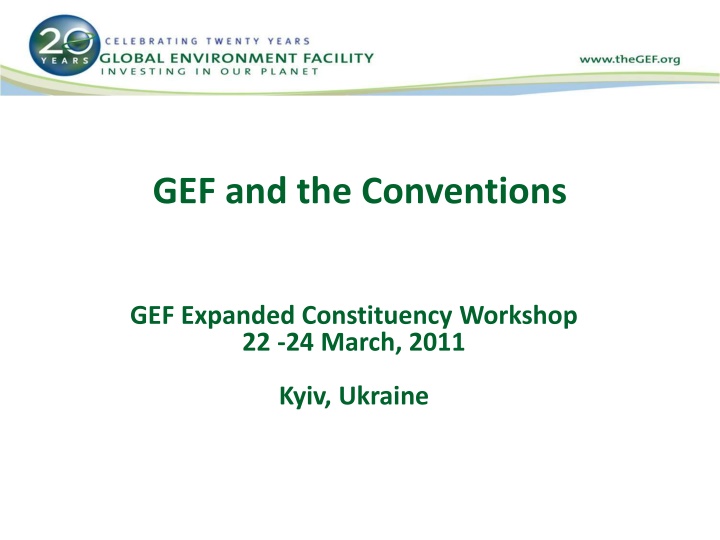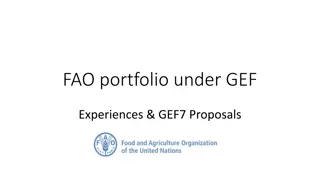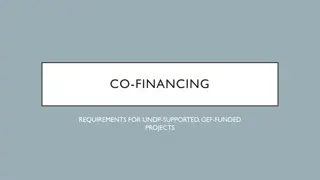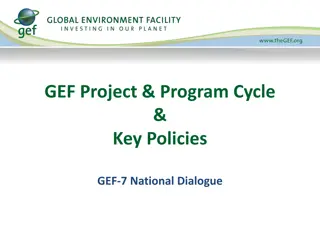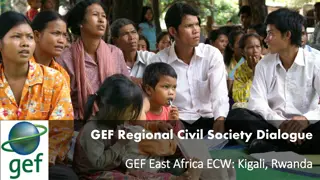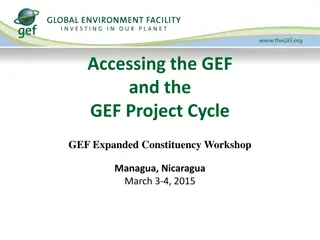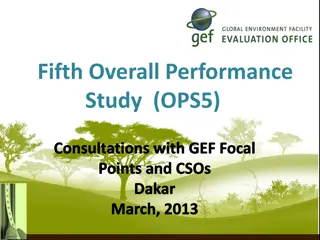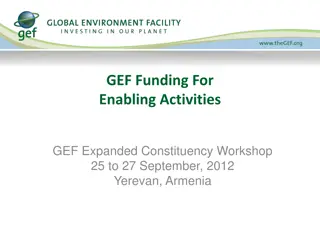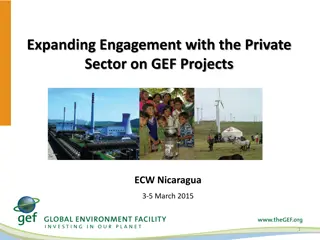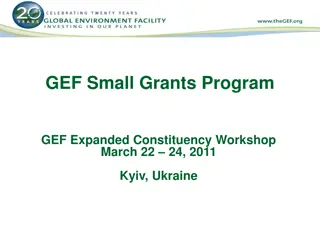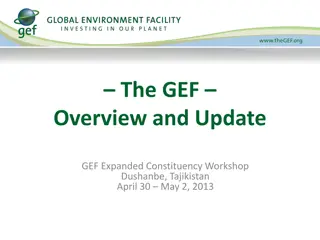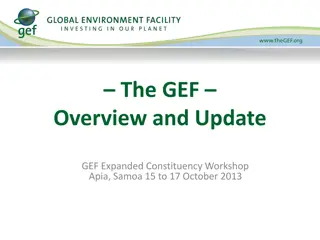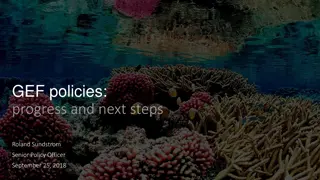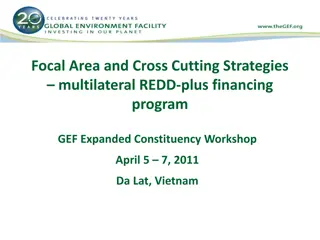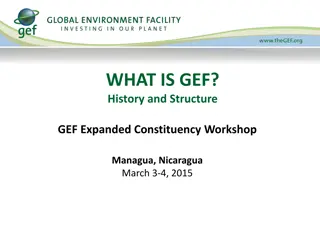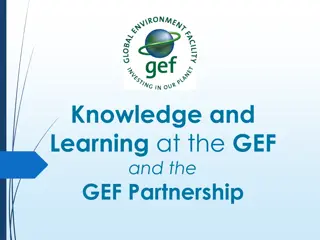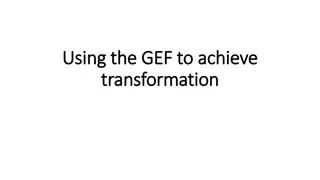GEF and the Conventions Workshop in Kyiv 2011
The Global Environment Facility (GEF) plays a crucial role in assisting developing countries to meet the objectives of international environmental conventions. This includes funding support for conservation of biodiversity, sustainable use of biodiversity, capacity building for convention implementation, and more. The Biodiversity Focal Area Strategy outlines key priorities and objectives aimed at promoting biodiversity conservation, sustainable use, and mainstreaming into national policies. The GEF-5 Strategy focuses on building capacity for access to genetic resources and benefit sharing, safeguarding biodiversity, and enhancing the effectiveness of protected area management.
Download Presentation

Please find below an Image/Link to download the presentation.
The content on the website is provided AS IS for your information and personal use only. It may not be sold, licensed, or shared on other websites without obtaining consent from the author.If you encounter any issues during the download, it is possible that the publisher has removed the file from their server.
You are allowed to download the files provided on this website for personal or commercial use, subject to the condition that they are used lawfully. All files are the property of their respective owners.
The content on the website is provided AS IS for your information and personal use only. It may not be sold, licensed, or shared on other websites without obtaining consent from the author.
E N D
Presentation Transcript
GEF and the Conventions GEF Expanded Constituency Workshop 22 -24 March, 2011 Kyiv, Ukraine
GEF and the conventions The GEF provides funding to assist developing countries in meeting the objectives of international environmental conventions. The GEF serves as "financial mechanism" for four conventions: The Convention on Biological Diversity The United Nations Framework Convention on Climate Change The United Nations Convention to Combat Desertification The Stockholm Convention on Persistent Organic Pollutants
Biodiversity Focal Area Strategy and CBD COP Guidance COP 2010-2014 Programme Priorities GEF-5 Strategy Objectives Programme priority area 1: Promote conservation of biological diversity, including through catalyzing sustainability of protected area systems Programme priority area 2: Promote sustainable use of biodiversity Programme priority area 2: Promote sustainable use of biodiversity Programme priority area 3: Mainstream biological diversity into various national sectoral policies development strategies programs Programme priority area 4: Improve national capacity to implement the Convention and the Cartagena Protocol on Biosafety Objective One: Improve Sustainability of Protected Area Systems Objective Two: Mainstream Biodiversity Conservation Sustainable Use into Production Landscapes/Seascapes Sectors Objectives One and Two as above, Objective Four: Build Capacity on Access to Genetic Resources and Benefit Sharing Objective Five: Integrate CBD Obligations into National Planning Processes through Enabling Activities. Objective Three: Build Capacity for the Implementation of the Cartagena Protocol on Biosafety
Biodiversity Focal Area Strategy and CBD COP Guidance COP 2010-2014 Programme Priorities Programme priority area 5: Promote the implementation of the Convention s third objective support the implementation of the international regime on access to genetic resources benefit-sharing GEF-5 Strategy Objectives Objective Four: Build Capacity on Access to Genetic Resources Benefit Sharing Programme priority area 6: Safeguard biodiversity Objective Two: Mainstream Biodiversity Sustainable Use into Production Landscapes Seascapes Sectors Objective One: Improve Sustainability of Protected Area Systems: c) Improve management effectiveness of existing protected areas Objective Three: Build Capacity for the Implementation of the Cartagena Protocol on Biosafety
Climate Change Focal Area Strategy and UNFCCC COP Guidance In response to Convention guidance, the GEF has provided financial and technical support to more than 150 non-Annex I Parties to prepare their initial, second, and, in some cases, third national communications to the Convention. During GEF-3, the GEF funded a global program to support the second national communications of most eligible countries. During GEF-5, the GEF will continue to provide finance for national communications In response to COP decision 2/CP.12, the GEF launched a strategic program during GEF-4 to promote the reduction of GHG emissions from Land Use, Land-Use Change and Forestry (LULUCF) within the climate change focal area. In GEF-5, the GEF has established the cross-cutting initiative of Sustainable Forest Management (SFM). At COP13, the GEF was requested to elaborate a strategic program to scale up the level of investment in technology transfer to help developing countries address their needs for environmentally sound technologies GEF established the Poznan Strategic Program on Technology Transfer
Climate Change Adaptation Strategy and UNFCCC COP Guidance At COP7 in 2001, the UNFCCC asked the GEF to finance adaptation pilot and demonstration projects. The GEF establish the Strategic Priority on Adaptation (SPA) during GEF-3/GEF-4 under the GEF trust fund in response to guidance from the COP. (e.g. decision 5/CP.7) COP7 asked the GEF to manage two voluntary adaptation-focused funds, the Least Developed Countries Fund (LDCF) and the Special Climate Change Fund (SCCF); The GEF is continuing to fundraise and replenish the LDCF and SCCF in response to Convention guidance and conclusions of the subsidiary bodies of the UNFCCC, (e.g. at the 26th session of the SBI) The conclusions at SBI 31 have recognized the steps the GEF has taken to enhance the support of the implementation of NAPAs
Land Degradation Focal Area Strategy and UNCCD COP Guidance As a new UNCCD financial mechanism, the GEF is currently clarifying how its land degradation focal area strategy will directly contribute to implementation of the UNCCD, including its ten-year (2008 2018) Strategic Plan and Framework adopted by the eighth COP. When developing the latest strategy for the land degradation focal area, the Technical Advisory Group (TAG) included a representative of the UNCCD, who provided guidance as the TAG explicitly sought to accept the COP s invitation to the GEF to take into account this ten year strategic plan and to align its operations accordingly in order to facilitate effective implementation of the Convention
POPS Focal Area Strategy and Stockholm Convention Guidance The GEF POPs strategy responds to guidance adopted by the COP to the Stockholm Convention at its first four meetings. The latest guidance adopted by the COP at its fourth meeting in May 2009 reaffirms the central guiding principle that the GEF should take into account the priorities identified by Parties in their implementation plans transmitted to the Conference of the Parties , and further highlights the preparation and update of NIPs, alternatives to DDT for disease vector control, and information exchange. The GEF s mandate as financial mechanism of the Stockholm Convention will require addressing the newly listed chemicals under the Convention.
Enabling Activities Focal Area Maximum Grant Purpose Biodiversity $500,000 USD Report to Convention on Biodiversity and Biosafety and National Biosafety Strategies and Action Plans (NBSAPs) Climate Change $500,000 USD National Communications LDCF $200,000 USD National Adaptation Programme of Action (NAPA) Land Degredation $150,000 USD Can be used for alignment of NAPs and country strategies with the UNCCD 10 year strategy Chemicals $250,000 USD Prepare and update NIPs
Direct Access Grants for Convention Reports: Activity Implementation Process
